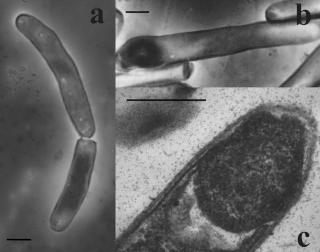Related Research Articles
The Thermomicrobia is a group of thermophilic green non-sulfur bacteria. Based on species Thermomicrobium roseum and Sphaerobacter thermophilus, this bacteria class has the following description:

Thermus is a genus of thermophilic bacteria. It is one of several bacteria belonging to the Deinococcota phylum. Thermus species can be distinguished from other genera in the family Thermaceae as well as all other bacteria by the presence of eight conserved signature indels (CSIs) found in proteins such as adenylate kinase and replicative DNA helicase as well as 14 conserved signature proteins (CSPs) that are exclusively shared by members of this genus.
The Alicyclobacillaceae are a family of Gram-positive bacteria. All members of this family are aerobic and form endospores.
Adlercreutzia is a genus in the phylum Actinomycetota (Bacteria).
Deferribacter is a genus in the phylum Deferribacterota (Bacteria).
The Nautiliaceae are a family of bacteria placed in an order to itself, Nautiliales, or in the order Campylobacterales. The members of the family are all thermophilic.
Streptomonospora is a Gram-positive and aerobic bacterial genus from the family of Nocardiopsaceae.

Carboxydocella is a Gram-positive and obligate anaerobe bacterial genus from the family of Syntrophomonadaceae.
Laceyella tengchongensis is a thermophilic bacterium from the genus of Laceyella which has been isolated from soil from the Big Empty Volcano in Tengchong in China.
Planifilum is a Gram-positive and aerobic bacterial genus from the family of Thermoactinomycetaceae.
Caldanaerobacter is a Gram-positive or negative and strictly anaerobic genus of bacteria from the family of Thermoanaerobacteraceae.
Caldanaerobius is a genus of thermophilic, obligately anaerobic bacteria from the family of Thermoanaerobacteraceae.
Conexibacter is a Gram-positive, non-spore-forming and aerobic genus of bacteria from the family Conexibacteraceae.
Sphaerisporangium is a Gram-positive genus of bacteria from the family of Streptosporangiaceae.
Solirubrobacter is a Gram-positive, spore-forming, aerobic, mesophilic and non-motile genus of bacteria from the family Solirubrobacteraceae.
Blastococcus is a Gram-positive, coccoid and aerobic genus of bacteria from the family of Geodermatophilaceae.
Olsenella is a Gram-positive, non-spore-forming, obligate anaerobic and non-motile bacterial genus from the family Atopobiaceae. Olsenella is named after the microbiologist Ingar Olsen. Olsenella bacteria are involved in endodontic infections in humans.
Anaerolineaceae is a family of bacteria from the order of Anaerolineales. Anaerolineaceae bacteria occur in marine sediments. There are a total of twelve genera in this family, most of which only encompass one species. All known members of the family are Gram-negative and non-motile. They also do not form bacterial spores and are either mesophilic or thermophilic obligate anaerobes. It is also known that all species in this family are chemoheterotrophs.
Effusibacillus is a genus of Gram-positive, rod-shaped, aerobic, spore-forming bacteria.
Knoellia is a genus of Gram positive, aerobic, non-endosporeforming bacteria. Species in this genus are mesophilic and have cells that are irregular rods or coccoid.
References
- 1 2 3 J.P. Euzéby. "Laceyella". List of Prokaryotic names with Standing in Nomenclature (LPSN). Retrieved 20 March 2023.
- ↑ Niall A. Logan; Paul De Vos, eds. (2011). Endospore-forming Soil Bacteria. Berlin: Springer. ISBN 978-3-642-19577-8.
- ↑ "Laceyella". www.uniprot.org.
- ↑ Goodfellow, Michael; Jones, Amanda L. (1 January 2015). "Laceyella". Bergey's Manual of Systematics of Archaea and Bacteria. John Wiley & Sons, Ltd: 1–4. doi:10.1002/9781118960608.gbm00570. ISBN 9781118960608.
- ↑ Paul, De Vos (2009). Bergey's manual of systematic bacteriology (2nd ed.). Dordrecht: Springer. ISBN 978-0-387-68489-5.
- ↑ Sayers; et al. "Laceyella". National Center for Biotechnology Information (NCBI) taxonomy database. Retrieved 20 March 2023.
- ↑ "The LTP" . Retrieved 20 November 2023.
- ↑ "LTP_all tree in newick format" . Retrieved 20 November 2023.
- ↑ "LTP_08_2023 Release Notes" (PDF). Retrieved 20 November 2023.
- ↑ "GTDB release 08-RS214". Genome Taxonomy Database . Retrieved 10 May 2023.
- ↑ "bac120_r214.sp_label". Genome Taxonomy Database . Retrieved 10 May 2023.
- ↑ "Taxon History". Genome Taxonomy Database . Retrieved 10 May 2023.